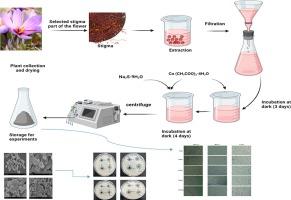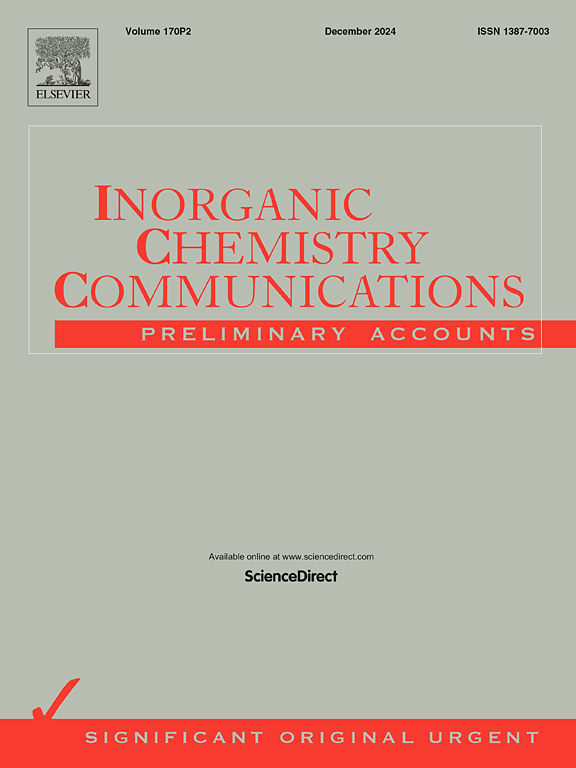Green approach of cobalt sulfide nanoparticles from novel red stigma of Crocus sativus and multifaceted biomedical advancement
IF 4.4
3区 化学
Q1 CHEMISTRY, INORGANIC & NUCLEAR
引用次数: 0
Abstract
The present study was based on green protocols for synthesizing cobalt sulfide nanoparticles using saffron stigma flower extract (Crocus sativus), as saffron is considered a potent traditional medicine. The novel cobalt sulfide (CoS) nanoparticles prepared by the green approach for the first time with saffron improved showed cytotoxicity and antibacterial activity, as well as significant antitumor activity of Hela, A549, and MCF 7 cells viz in vitro studies. The saffron-cobalt sulfide nanoparticles underwent characterization using various techniques which include the X-ray diffraction (XRD), Fourier transform infrared spectroscopy (FTIR), Advances in scanning electron microscopy (SEM), and high-resolution transmission electron microscopy (HR-TEM), and the energy dispersive X-ray analysis spectroscopy. Both XRD, and FTIR confirmed the synthesis of pure cobalt sulfide nanoparticles. The resulting saffron-based cobalt sulfide nanoparticles exhibited a nanosphere structure, as confirmed by HRTEM, indicating the formation of nanosphere and microstructures. In vitro studies were conducted to assess the cytotoxicity and cell viability of Hela cells, A549, and MCF-7 cells. And, antibacterial studies were performed against various bacterial strains using different concentrations of cobalt sulfide nanoparticles derived from the red stigma of saffron (Crocus sativus) only the red stigma extract. The MTT assay analysis, cell viability, and morphological studies demonstrated the cytotoxic studies of the synthesized cobalt sulfide nanoparticles on cancer cells. The antibacterial test of the nanoparticles was also evaluated, revealing significant zones of inhibition (mm) against pathogens and cobalt sulfide nanoparticles using saffron extract, showcasing their potent cytotoxic, antibacterial, and antitumor activities with promising biomedical applications.

从新颖的番红花红色柱头中提取硫化钴纳米粒子的绿色方法和多方面的生物医学进步
藏红花被认为是一种有效的传统药物,本研究基于利用藏红花柱头花提取物(Crocus sativus)合成硫化钴纳米粒子的绿色方案。利用藏红花改进的绿色方法首次制备的新型硫化钴(CoS)纳米粒子显示出细胞毒性和抗菌活性,并在体外研究中显示出对 Hela、A549 和 MCF 7 细胞的显著抗肿瘤活性。藏红花-硫化钴纳米粒子采用了多种技术进行表征,包括 X 射线衍射 (XRD)、傅立叶变换红外光谱 (FTIR)、先进的扫描电子显微镜 (SEM)、高分辨率透射电子显微镜 (HR-TEM) 和能量色散 X 射线分析光谱。X 射线衍射和傅立叶变换红外光谱证实了纯硫化钴纳米粒子的合成。红花基硫化钴纳米粒子呈现出纳米球状结构,HR-TEM 证实了这一点,表明形成了纳米球和微结构。体外研究评估了 Hela 细胞、A549 细胞和 MCF-7 细胞的细胞毒性和细胞活力。此外,还使用从藏红花(Crocus sativus)红色柱头(仅红色柱头提取物)中提取的不同浓度的硫化钴纳米粒子对各种细菌菌株进行了抗菌研究。MTT 分析、细胞活力和形态学研究表明,合成的硫化钴纳米粒子对癌细胞具有细胞毒性。此外,还对纳米粒子的抗菌测试进行了评估,结果显示,使用藏红花提取物合成的硫化钴纳米粒子对病原体和硫化钴纳米粒子有显著的抑制区(毫米),显示了其强大的细胞毒性、抗菌和抗肿瘤活性,具有广阔的生物医学应用前景。
本文章由计算机程序翻译,如有差异,请以英文原文为准。
求助全文
约1分钟内获得全文
求助全文
来源期刊

Inorganic Chemistry Communications
化学-无机化学与核化学
CiteScore
5.50
自引率
7.90%
发文量
1013
审稿时长
53 days
期刊介绍:
Launched in January 1998, Inorganic Chemistry Communications is an international journal dedicated to the rapid publication of short communications in the major areas of inorganic, organometallic and supramolecular chemistry. Topics include synthetic and reaction chemistry, kinetics and mechanisms of reactions, bioinorganic chemistry, photochemistry and the use of metal and organometallic compounds in stoichiometric and catalytic synthesis or organic compounds.
 求助内容:
求助内容: 应助结果提醒方式:
应助结果提醒方式:


